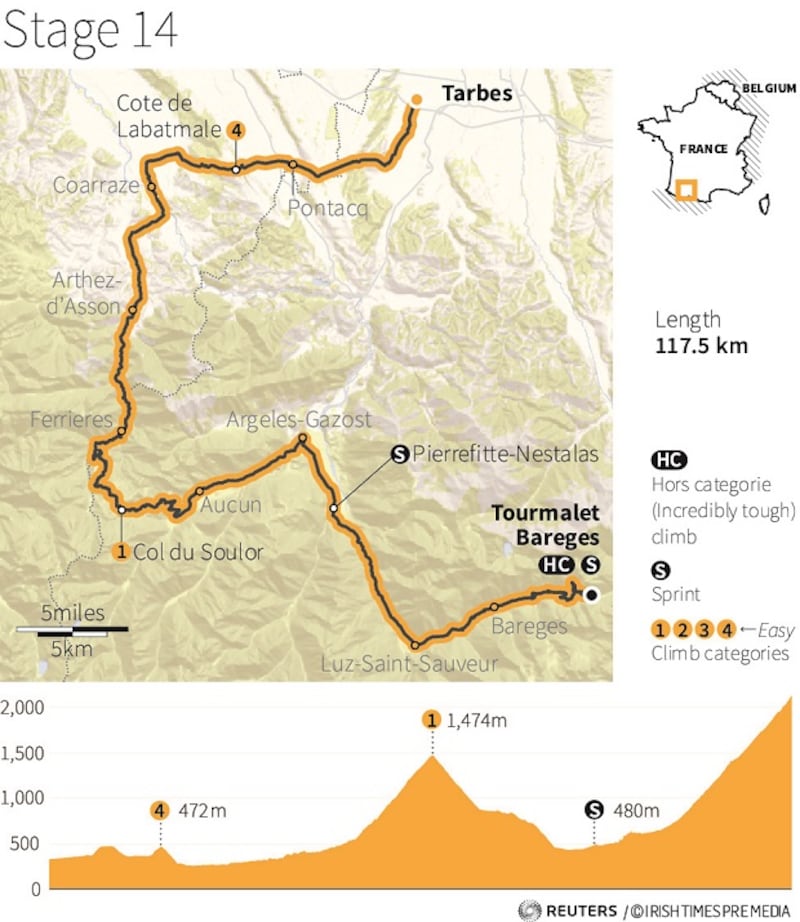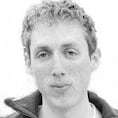There's just over one week left in this Tour, and we are now heading into my favourite terrain. The mountains are what makes the Tour de France really epic and, with several peaks over 2,000 metres in altitude, the hope is that this year will be even more special than usual.
Friday was the Tour’s individual time trial, and that brought an end to the stages where traditionally I am most vulnerable. Heading into the race, I had a simple goal for these first 13 days: stay upright, stay healthy and limit my time losses. That meant not being caught out on the flatter, windier stages, and also doing as well as possible in the team time trial on day two and in Friday’s time trial.
There were real risks in the past week. Last Monday's stage to Albi could have been dangerous due to splits in the winds, but I really stayed focused for the whole stage and finished in the front group. In contrast, some other general classification riders such as 2017 runner-up Rigoberto Urán (EF Education First) and Jakob Fuglsang (Astana Pro Team) lost almost two minutes, putting a big dent in their hopes.
Staying out of trouble that day was really about remaining completely focused and defending your position all the way. At one point, for example, there were a couple of roundabouts. I looked ahead and realised that when we went around the second one, we would be turning back into the crosswinds and that there would be chaos. So I just sprinted as hard as I could and I ended up being right at the front when they hit the wind and the hammer went down.
That broke things up and the speed went through the roof to keep those gaps. The last half an hour was incredibly fast – we averaged 59 kilometres per hour for that part of the race. It was just so, so fast, especially after 200 kilometres and after 10 days of racing. In the past I have been on the wrong side of the splits in situations like that, but obviously this worked out well for us.
That was a nice way to go into the rest day, and put me and the team in a good position when things got going again on Wednesday. Thursday’s first Pyrenean mountain stage was special for me in that it covered the same roads towards the end as when I won my first Tour stage in 2013. But although there were two big climbs towards the end, the bunch of general classification contenders ended up staying together.
Chased down
There were a couple of reasons for this. Team Ineos had their full team still there, so any rider trying to break away was going to be chased down. And there was a strong headwind on the last climb and also in the last 30 kilometres. It meant that any energy spent was likely to be wasted, which was something to avoid with a time trial the next day.
I guess some of the contenders could have got excited on the first mountain stage, starting firing off attacks, but you have to remember that we had got eight stages left at that point, and six of them were going to be crucial in the battle for the GC. The Tour is definitely about saving energy for when it is needed, and so things were less active than some expected.
Everything builds up towards this second half of the race; that's where the action will really happen
In the past, I have been one of the riders to really shake things up by being aggressive. This year I am much more aware of only using energy when it counts. I guess you can say that I have learned from my mistakes. Before, I would attack and think, 'maybe they will let me go.' But after being chased down over and over again, I know they won't do that. I think I am better at spotting opportunities now. That said, there hasn't really been that many opportunities to attack this year so far. With the way the route has been designed, there hasn't been a stage where I could really have an opportunity to try to go for the stage win. There hasn't been a finish like the Mur de Bretagne, where I won last year. Everything builds up towards this second half of the race; that's where the action will really happen.
Friday’s time trial went okay for me. I was 33rd, which might not sound spectacular, but as a non-time trial specialist I was happy enough with how it went. I think I did a really good ride. I took the corners well and did good pacing the whole way. It is a positive sign for the mountains ahead. The result is the result – you can only do your best. You can’t really change that.
There or thereabouts
Looking at the others, I was there or thereabouts with many of the general classification riders. I was more or less on the same time as Adam Yates, and I put 20 seconds into Romain Bardet. I am 11th overall, and am still less than three minutes behind Geraint Thomas, who is second in the general classification. The stages that are most dangerous for me are behind us now, and we are heading into the high mountains, which is something that excites me a lot.
Julian is riding on confidence and momentum, and is getting huge support from the French
The big question after the time trial is how Julian Alaphilippe can do. He went into the stage in the yellow jersey and did an incredible ride, winning the stage and strengthening his overall lead.
Julian is a former team-mate of mine and I know him well. He is riding on confidence and momentum, and is getting huge support from the French. He wasn’t a favourite heading into the race and everybody is still kind of expecting him to drop out of the equation, but I am not expecting anything. The way he is riding, he could definitely take this thing all the way to Paris.
Basically, he has nothing to lose: he will be very happy with his Tour. Whatever happens, he has won two stages and has loved every minute of being in yellow. Every day is a bonus, and he has done an amazing race. The way I see it, if he drops time at all, it will be in one big explosion. He will give it everything and then he will either keep the yellow jersey all the way to Paris, or the batteries will suddenly run flat. At the moment he has done an incredible race.
Threat
As things stand, I think that everyone is a threat. I don’t think the time gaps in the general classification are big enough to discount anyone at the moment, particularly with the mountains that are coming. We have effectively got five really hard mountain stages and the one to Gap, which is kind of a half-hard day still to go. There is everything to play for in this Tour and all you need to lose is 30 seconds to a minute on each mountain stage, which isn’t a lot really, and you can drop five, six minutes in total.

Saturday’s race is the first really big mountain stage. We had the uphill finish on stage six to La Planche des Belles Filles, but that is nothing like Saturday’s race to the top of the Tourmalet. La Planche des Belles Filles was just over 1,100 metres in altitude; the Tourmalet is 2,115 metres above sea level. Nobody has been anywhere near that altitude in the past 2½ weeks, and that brings a lot of unknowns. The last climb is also about 31, 32 kilometres long, and that too underlines how hard it will be.
I have done the Tourmalet quite a few times in the past. I have always had a good day every time the race has gone over the climb. So hopefully I will have another good day, get a good result and boost the confidence for the stages going forward.














